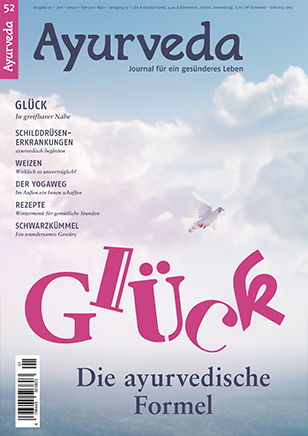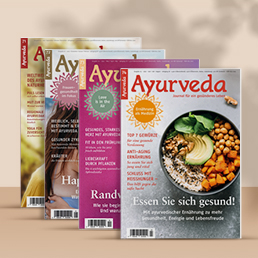Small organ – great importance: The thyroid gland influences the metabolism and functional state of almost all organs. Its health is therefore of overriding relevance from an Ayurvedic point of view.
Hardly any other organ reacts so sensitively to stress and, conversely, affects the psyche so quickly in the event of illness as the thyroid gland. This places a considerable burden on those affected, and they feel inadequately understood and accompanied by the administration of thyroid hormones or iodine tablets alone. In my practice, I often see thyroid patients who are subjectively much worse off than their laboratory values and ultrasound images would “objectively” suggest. And this is exactly where the great strength of Ayurvedic medicine lies: It evaluates symptoms in all their interrelationships, explores causes and consequences, considers body, senses and mind as a unity and treats not only the disease, but the person behind it.
Even if the thyroid gland as an organ was unknown in classical Ayurveda, already 2000 years ago disease patterns and their therapies were described, which are comparable to today’s thyroid diseases. The treatment successes in Ayurvedic practice speak for themselves.
The organ and its functions
The butterfly-shaped thyroid gland consists of two glandular lobes, which are located at the level of the larynx to the right and left of the trachea and correspond in their dimensions to a large olive. As an endocrine gland, it produces the iodine-containing thyroid hormones triiodothyronine (T3) and thyroxine (T4) as well as calcitonin and releases these into the blood. The thyroid hormones T3 and T4 stimulate the energy metabolism and increase the basal metabolic rate, which means the energy consumption at rest. From an Ayurvedic point of view, this is regulated by our body fire “Agni“. A strong Agni therefore stimulates thyroid function, and a healthy thyroid maintains a healthy Agni.
Cardiovascular and gastrointestinal functions are influenced by thyroid hormones, as is our body temperature. Bone growth and brain maturation are promoted, which is of great importance during pregnancy and childhood.
The regulation of the thyroid gland is subject to an extremely exciting control loop: the hypothalamus, located in the diencephalon, stimulates the pituitary gland via the messenger substance TRH, which in turn stimulates the thyroid gland to produce hormones via the hormone TSH. In the blood, the respective hormone status is measured via receptors and sent as feedback to the pituitary gland and the hypothalamus. Depending on the hormonal milieu, there is now further stimulation or inhibition of the thyroid gland by the two higher-level hormonal glands. In Ayurveda, we love such interrelationships – any change at one point in the cycle alters the entire cascade of hormone production. This is also where the principle of constant change becomes apparent: your blood values today are only a snapshot, and as soon as you read them, the conditions have already readjusted. The thyroid gland cannot be understood and treated statically, but only in its entire dynamic.
The importance of iodine
Iodine is an essential trace element that our thyroid gland needs to produce hormones. If iodine is deficient, the thyroid gland initially enlarges diffusely (goiter). If the deficiency persists, nodular remodeling, cysts or calcifications develop over the years. About 35% of the German population have an enlargement and/or nodular alteration of the thyroid gland.
To meet the daily iodine requirement of about 200 micrograms, salt is iodized in Germany. Iodide is a synthetic iodine compound that is foreign to our thyroid gland and, moreover, can never be one hundred percent pure. With government subsidies, iodine is recycled from hazardous waste (including printing ink, disinfectants, X-ray contrast media). The danger of overdosing is high – the regular consumption of pizza and sausages alone leads to an oversupply. Therefore my urgent advice: Stay away from synthetic iodized salt! But it could be so simple: Everything that comes from the sea contains natural iodine. This is known to our body and is metabolized better. The consumption of sea salt and seaweed such as nori, sea lettuce or wakame can easily ensure the supply. And an additional benefit is guaranteed: Seaweed has the highest micronutrient density of any food on the planet.
Thyroid gland from ayurvedic point of view
Structurally, the thyroid gland can be physiologically assigned to the sixth of seven body tissues, Majja Dhatu (medulla and nervous tissue), with its embedding in the neuroendocrine regulatory circuit described above.
If it becomes diseased, other body tissues may be affected:
- Rasa Dhatu (nutrient juice) – edema or pronounced dryness occurs.
- Rakta Dhatu (blood) – there is stimulation or inhibition of blood formation.
- Mamsa Dhatu (flesh) – there is swelling, nodules or cysts.
- Meda Dhatu (fat) – there is an increase or decrease in body fat.
- Asthi Dhatu (bone) – bone loss (osteoporosis) occurs.
- Shukra Dhatu (reproductive tissue) – infertility occurs.
Functionally, the thyroid gland is closely related to Agni, Vata, Pitta and Kapha:
- The strength of Agni is proportional to thyroid function.
- Vata and Pitta correlate with strong function of the organ.
- Kapha symptoms appear when the thyroid gland is weak in function.
Diseases of the thyroid gland
The thyroid gland can become structurally and functionally diseased. Both types influence each other.
- Goiter – enlargement of the thyroid gland
- Hypothyroidism – underactivity
- Hyperthyroidism – overactivity
- Thyroiditis – inflammation of the thyroid gland
In this article, I will focus on the first three disorders, as the explanation of thyroiditis from an Ayurvedic perspective is beyond the scope and will therefore be covered in a separate article at a later date.
The enlargement of the thyroid gland
The cause of goiter is usually associated with a deficiency of iodine or selenium. Other causes are drugs, toxins or autoimmune diseases. Those affected complain of a tightness in the throat, difficulty swallowing and breathing, fatigue and hoarseness. The goiter is ayurvedically assigned to Kapha Dosha and to a weak Agni of the third body tissue, through which this “Mamsa Dhatu” increases in immature form.
Therapeutically, we first avoid all factors that unnecessarily increase Kapha, for example:
- foods such as cheese, meat, fresh cereals or sweets
- sleeping late, daytime sleep, sleep immediately after meals
- lack of exercise or sedentary activities
We have already discussed the healthy intake of iodine. Selenium is found Ayurvedically mainly in Brazil nuts, unpolished rice, mung and uriddal. Growth processes are treated in Ayurveda by a “scratching” strategy (lekhana). Phytotherapeutically, products based on the tree resin guggulu (Indian myrrh) are used for this purpose, the most important formulation being Kanchanara Guggulu.
Manualtherapeutic local compresses can be used after prior diagnostic clarification by an Ayurveda specialist.
The hypothyroidism
Hypothyroidism can be caused by the thyroid gland itself or its higher-level control centers (pituitary, hypothalamus). It may be latent (T3/T4 are still within the normal range, TSH is already elevated) or manifest (T3/T4 are decreased). There are congenital and acquired hypofunctions, the latter usually resulting from thyroiditis. Affected persons suffer from a systemic slowdown, they feel tired, low in drive and disinterested. The ability to concentrate dwindles, blood pressure and heart rate drop, sensitivity to cold increases. Appetite is low, defecation difficult, and libido also weakens. At the same time, body weight increases despite low food intake and lipometabolic disorders develop. Ayurvedically, this clinical picture is a prototype for high Kapha with low Agni. The characteristics (guna) cold, heavy and sluggish are in the foreground and cause 80% of all symptoms. Therapeutically, it is therefore important to stimulate the organ by heating, light and stimulating measures, to strengthen Agni and to lower Kapha.
Nutritional-therapeutic recommendations are similar to those used for goiter. The dietary system is primarily vegetarian – in terms of animal substances, only dark old honey, Ayurvedic buttermilk and in small quantities ghee are recommended. Fresh vegetables, light, gluten-free cereals and mungdal are primarily on the menu for the time being and are prepared with spicy and bitter seasoning.
In terms of exercise therapy, I work with the patient to develop a daily workout plan that can be implemented and includes strengthening his basic muscular characteristics of endurance, strength and flexibility.
Breath-therapeutically, “Ujjayi Pranayama” (the victorious breathing) stimulates the thyroid gland. This involves whispering the sound “Haaa” exhaling and inhaling with the mouth closed, thus narrowing the glottis. However, this exercise is prohibited in case of vocal cord problems or inflammations in the throat area – therefore, have a knowledgeable therapist instruct you.
Phytotherapeutically, in addition to the guggulu products mentioned for goiter, pungent medicinal plants such as trikatu (a mixture of dry ginger, long and black pepper) and bitter substances are used. Under professional guidance with a targeted cure diet, I often recommend the implementation of Vardhamana Pippali, a staircase cure with powdered long pepper for 15-30 days.
I regularly recommend panchakarma programs to hypothyroid patients for reduction of excess body tissues, stimulation of digestion and metabolism, and psychological mood elevation. If in-patient programs lasting several weeks are not possible for organizational reasons, individual elimination procedures can also be accompanied on an out-patient basis. Hypothyroid patients receive thyroid hormones from Western medicine, which they must continue to take in the vast majority of cases to accompany Ayurvedic therapy. In my experience, however, the amounts of hormones required can often be reduced by a combined therapy.
The hyperthyroidism
Hyperthyroidism occurs autoimmunologically, in the context of thyroid autonomy (autonomy of parts of the thyroid tissue from the thyrotropic control circuit), concomitant with tumor disease or as a result of inflammation. In about 80 % of all cases a goiter is present. During pregnancy, a mild, latent form often occurs, which usually normalizes itself in the course of time. In hyperthyroidism, too many hormones are produced and the metabolism accelerates. Those affected suffer from weight loss, palpitations, a feeling of heat and sweating, fine-beat tremors, hair loss, diarrhea and sleep disturbances. The pronounced restlessness and nervousness coupled with mood swings puts a strain on social relationships in partnerships and at work, sometimes considerably.
In individual cases, especially in autoimmunologically caused Graves’ disease, eye complaints are also present: these include sensitivity to light, a feeling of pressure, tearing, double vision, and even bulging of the eyeballs (exophthalmos). Hyperthyroid patients need urgent and fast help, as they are progressively weakened by their disease. Tissues can no longer be sufficiently built up and maintained, a lack of vital energy (ojas) is the result. This weakens the immune system and puts somatopsychic strain on the mind. Many affected people therefore suffer from anxiety. In hyperfunction, Vata and Pitta Dosha are aggravated, the primary affected qualities (Guna) are light, accelerated and hot. Agni burns too much (tikshnagni) and consumes body tissues.
Therefore, in therapy, slowing, cooling and stabilizing measures are applied. In terms of nutritional therapy, the blazing fire needs sufficient firewood. Therefore, we switch the affected patients to a 3+2 meal system (three main meals, two snacks). Whole grains are on the menu, as are dairy products, protein-rich legumes and, in frequent cases, white meat. It is important to prevent the breakdown of tissues and body strength. Caffeinated and alcoholic beverages as well as hot spices and preparation methods should be consistently avoided.
In terms of order therapy, I place great emphasis on promoting a long, restful night’s sleep. Sports activities should be limited to strength programs and yoga to avoid expending even more energy. Time pressure is poison for hyperthyroid patients, so it is important to plan work and rest periods realistically.
Breathing therapy and training in meditation are worth their weight in gold for sufferers. Daily “breathing breaks” to deepen and slow breathing into all areas of the respiratory system act as an elixir, and morning and evening meditation practice helps the mind to center itself despite all the restlessness.
Phytotherapeutically, products from the Brmhana (nourishment), Medhya (nerve strengthening) and Rasayana (regeneration) groups are used. Many recipes include plants such as Shatavari, Bala, Vidarikanda, Gokshura, Ashwagandha, Atmagupta, Brahmi and Mandukaparni. I strongly advise against self-experimentation.
Excretion procedures are absolutely contraindicated in patients with hyperthyroidism. However, spa therapy programs of variable duration can work wonders. Many patients require drug therapy with so-called thyreostatics, which inhibit excessive hormone production in the thyroid gland. In some cases, surgical measures are necessary when self-regulation is no longer possible.
Psychosomatics and somatopsychology
In the hypothalamus, nerve stimuli can be converted into hormonal signals. It is the supreme regulatory center for all vegetative and endocrine processes and controls, among other things, body temperature, food and fluid intake, daily and sleep rhythms, blood pressure and sexual behavior. Our mental balance directly affects the nervous and endocrine systems and can indirectly influence the healthy functioning of the thyroid gland. Longstanding unresolved social conflicts, chronic job dissatisfaction, partnership problems, financial or health concerns, and anxiety of any kind also have a psychosomatic impact on the thyroid gland as stressors. Conversely, our daily behavior in the context of sleeping and eating habits, sensory stimuli, movement and relaxation activities somatopsychically influences the function of the thyroid gland. A holistic therapy of this so small but wonderful organ considers both ways, from mind to body and from body to mind.
Our thyroid gland is much more than a hormone producer whose health can be determined purely by laboratory values. It teaches us to think in a networked way, to understand constant change and to experience ourselves as a unity of body, senses, mind and soul.

Issue 52 – Happiness
Unfortunately, this issue is no longer available.

 © Stocksy United / Ina Peters
© Stocksy United / Ina Peters 















